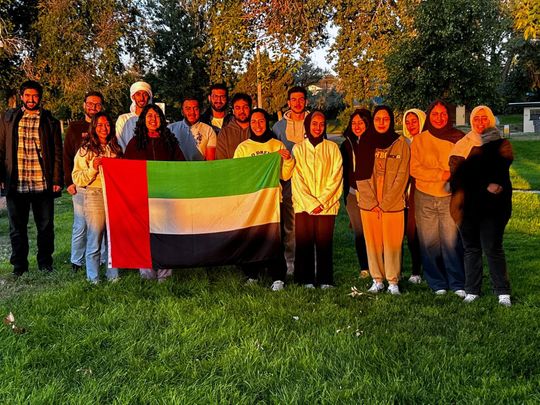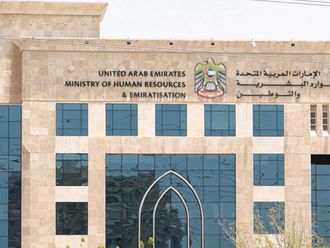
Colorado, US: Ahead of the UAE’s historic Emirates Mission to the Asteroid Belt (EMA), a team from the UAE Space Agency studied the mission’s final destination, asteroid Justitia, as it passed over a star in the US recently.
The EMA aims to explore seven asteroids, flying past six and culminating in a rendezvous with (269) Justitia, one of the most puzzling objects in the belt located between Mars and Jupiter.
‘MBR Explorer’, the mission’s spacecraft named after His Highness Sheikh Mohammed bin Rashid Al Maktoum, Vice President and Prime Minister of the UAE and Ruler of Dubai, will blast off to space in March 2028 for the “world’s first multiple-asteroid tour and landing mission.”
Stellar occultation
As it prepares for the ambitious project, the UAE Space Agency held the ‘stellar occultation campaign’ for the mission’s final asteroid, Justitia. An occultation is an event that occurs when one object is hidden from the observer by another object that passes between them.
The campaign aimed to collect data to form a deeper understanding of Justitia’s size, orbit, and albedo (the proportion of light reflected from its surface) by looking at the shadow of the asteroid as it passes in front of a star.
“This comes as part of the mission’s objective of successfully reaching its final asteroid, Justitia,” the agency said.
As the most advanced and ambitious scientific project, the Emirates Mission to the Asteroid Belt (EMA) is the first mission of its kind to explore seven asteroids in the main belt. It consists of a six-year spacecraft design and development phase followed by launch and a seven-year mission to the main asteroid belt beyond Mars, performing a series of flybys with six main belt asteroids and finally rendezvousing with the asteroid Justitia.
Read more
- You made us proud Sultan Al Neyadi, say UAE leaders and community
- Mission accomplished! Team MBRSC thrilled about triumphant return of UAE astronaut Sultan Al Neyadi from space
- UAE: Puzzle of ‘bizarre’ pulsar star unravelled by researchers in Abu Dhabi
- 'I am in good health': UAE astronaut Sultan Al Neyadi says in first post after return to Earth
Deeper understanding
Mohsen Al Awadhi, mission director of the EMA, said: “The campaign to observe Justitia as it passes in front of a star is a major step towards achieving the objectives of EMA. Having a deeper understanding of Justitia’s size, orbit, and albedo before launching the mission is essential to ensure its success, in addition to developing effective strategies to study it.”
Al Awadhi added: “We seek to expand the scientific horizons of national cadres and provide them with the necessary skills to lead the astronomical future of the UAE. This comes in line with the EMA, which extends over a period of 12 years between development, design, and the actual mission.”
The Explorer will fly by the Earth, Mars and six asteroids and will have a planned landing on the final asteroid in 2034. It will explore Justitia for seven months and send back valuable data for the global scientific community. The 5-billion-kilometre space mission aims to better understand the source of water on Earth and other planets by studying water and minerals in the asteroids
Student volunteers
The stellar occultation campaign to study Justitia was conducted by 60 volunteers which included EMA team members, University of Colorado students, Emirati students, and other occultation campaign volunteers. All volunteers had to take three trainings to prepare for the campaign, one during the daytime to learn how to set up the telescope, and two during the night-time at round 2am to 4am to learn how to collect data.
On the week of the campaign, based on the weather of the locations where Justitia’s shadow was going to pass over, the campaign’s base was selected to be Wheatland, Wyoming in the US.
“Telescopes were packed for the trip from Colorado to Wyoming with teams of two people per station. The teams arrived in Wheatland a day before the occultation date to scout for sites where they would be setting up their telescopes and to conduct a final training on-site at the same time that the real occultation was going to occur (4am) to ensure that everything was ready for the real event,” the space agency explained.
Data collection
On the evening of August 30, the team went out to their sites and set up their telescopes in order to observe the occultation of the target star by the asteroid Justitia. Across 34 stations, spaced by 2 km, the teams collected data on the light of the target star over time as the light went out when Justitia passed in front of it.
“The campaign occurred successfully and the data from each station is currently being combined to better determine the shape of Justitia,” said the space agency.
It said the campaign included Emirati volunteer students currently studying the US, Amer Al Sawwafi, Sultan Al Blooshi, Hamdan Al Mansoori, and Khalid Al Naqbi.
“The mission was determined to include as many Emirati students as possible to encourage them to participate in this vital sector and to develop their skills in astronomy and their understanding of the mission and its goals.”
The training is part of the UAE Space Agency’s initiatives to raise awareness of the importance of astronomical research and space exploration and to encourage the Emirati youth to participate in this vital sector. The agency said this supports its vision to develop the skills of Emirati cadres and empower them in the fields of space to ensure its sustainability.








